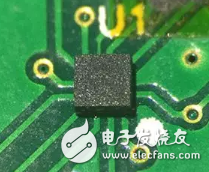At the 2018 Consumer Electronics Show (CES 2018) in Las Vegas, one of the world's largest electronics exhibitions, TDK and AKM unveiled a high-precision 3-axis magnetometer at their respective booths. This innovative sensor represents a significant advancement in magnetic sensing technology, offering enhanced accuracy and performance for a wide range of applications.
The new magnetometer integrates TDK’s highly sensitive tunneling magnetoresistive (TMR) components with AKM’s advanced electronic compass ASIC into a compact LGA 11-pin package. Measuring just 1.6 mm x 1.6 mm x 0.6 mm, this micro-sized chip boasts industry-leading performance, including an RMS noise level as low as 40 nT-rms, an output data rate of 100 Hz, and ultra-low power consumption of only 40 μA. These features make it ideal for use in space-constrained devices where precision is critical.

Thanks to its impressive sensitivity of 10 nT/LSB (least significant bit), the TMR magnetometer can accurately detect even the smallest changes in magnetic fields. This makes it well-suited for applications such as determining position and orientation using the Earth’s magnetic field or external magnetic sources. Its versatility allows it to be used in smartphones, tablets, game controllers, wearables, and more. It also supports emerging technologies like virtual reality (VR), augmented reality (AR), mixed reality (MR), and indoor navigation, where precise spatial awareness is essential.
Magnetic sensors are a crucial component in many modern devices, designed to detect and measure magnetic fields by converting them into electrical signals. They can sense various physical quantities, including the magnitude, direction, displacement, angle, and current of a magnetic field. These sensors are widely used across industries such as information technology, power systems, automotive, industrial automation, and biomedical engineering.
As technology continues to evolve, there is an increasing demand for smaller, more sensitive, thermally stable, and energy-efficient magnetic sensors. Traditional sensors based on electromagnetic induction or the Hall effect are being gradually replaced by those utilizing magnetoresistance effects, which offer better performance in terms of size, power consumption, and integration.
Currently, the most common magnetic sensor chips on the market are based on the Hall effect, anisotropic magnetoresistance (AMR), and giant magnetoresistance (GMR). However, TMR (tunneling magnetoresistance) sensors stand out due to their miniaturization, low cost, low power consumption, high integration, fast response time, and exceptional sensitivity. These advantages position TMR as a key player in future sensor technology.
While semiconductor Hall devices remain popular, their limitations—such as low sensitivity, susceptibility to stress and temperature, limited response frequency, and higher power usage—are driving the shift toward magnetoresistive sensors. In the global market, AMR, spin-valve, and TMR-based sensors have reached a mature stage, with mass production already underway.
TMR sensors are currently used in hard disk read heads and magnetic memory, with major manufacturers including Seagate, Western Digital, and TDK. AMR-based devices are produced by companies like Honeywell, NEC, and Japan Asahi Kasei, while NVE has started small-scale production of GMR sensors, and a few companies are experimenting with spin-valve sensors.
The development and manufacturing of TMR magnetic sensor chips rely heavily on advanced nanofilm and nano-scale electronic component production equipment, processes, and chip design. TMR technology is largely controlled by foreign hard drive manufacturers, and many magnetic sensor companies lack the necessary experience, talent, and production capabilities.
Globally, only two U.S.-based companies—NVE and Micro Magnetics—are capable of producing TMR magnetic sensor chips in small quantities. Domestically, the field remains underdeveloped due to limitations in equipment and human resources, leaving a significant gap in the market.
coin battery holder,cr2032 battery holder,cr2032 holder,cr2032 socket,cr2450 battery holder,cr2450 holder,2450 battery holder
Dongguan Yiyou Electronic Technology Co., Ltd. , https://www.dsubminiature.com